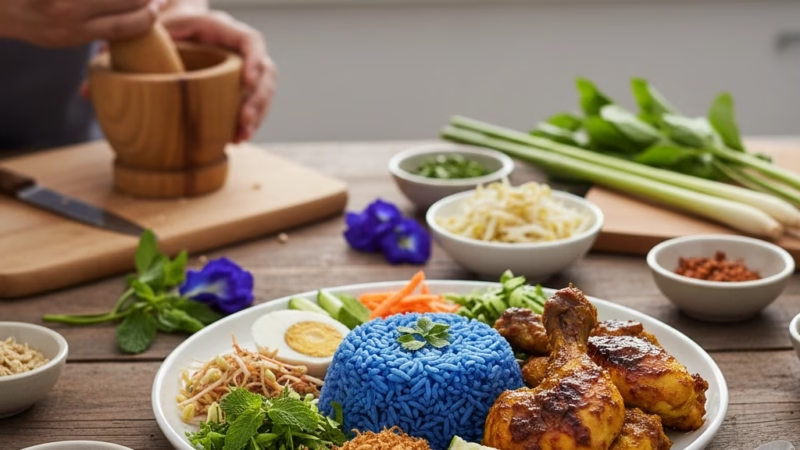How to Cook Nasi Kerabu at Home

Introduction
Learn how to cook Nasi Kerabu at home, a beloved Malaysian dish known for its striking blue rice, fragrant herbs, and flavorful accompaniments. Originating from Kelantan in East Coast Malaysia, this meal combines taste, culture, and artistry on a single plate. Whether you’re a beginner or a food lover looking to recreate authentic Malaysian flavors, this step-by-step guide will walk you through every detail—from making the blue rice to assembling the traditional side dishes.
Step 1: Gather Your Ingredients
To make Nasi Kerabu, prepare:
- For the Blue Rice: White rice, butterfly pea flowers (bunga telang), pandan leaves, salt.
- For the Herbs & Salad: Finely sliced lemongrass, kaffir lime leaves, Vietnamese mint (daun kesum), turmeric leaf, bean sprouts, long beans, cucumber.
- For the Sambal & Gravy: Dried chilies, shallots, garlic, shrimp paste, coconut milk, and a little tamarind juice.
- For the Protein: Grilled or fried fish (traditionally mackerel or catfish).
Tip: Butterfly pea flowers give the rice its signature blue hue—natural and rich in antioxidants.
Step 2: Prepare the Blue Rice
- Boil a handful of butterfly pea flowers in water until vibrant blue.
- Strain the water and use it to cook the rice, adding pandan leaves for aroma and a pinch of salt.
- Cook as usual in a rice cooker or pot.
Tip: For a deeper shade of blue, use more flowers or steep them longer.
Step 3: Make the Herb Salad (Ulam)
- Finely slice all the herbs and vegetables.
- Toss them together in a bowl—these provide freshness and fragrance to the dish.
- Keep them chilled until serving time.
Why it matters: The ulam adds crunch, aroma, and a burst of color that balances the creamy, spicy elements.
Step 4: Prepare the Sambal Kelapa (Coconut Sambal)
- Toast grated coconut until golden brown.
- Pound together chilies, shallots, garlic, and shrimp paste.
- Mix the spice paste with the toasted coconut and season with salt and lime juice.
Tip: Adjust spice level to taste—Kelantanese sambal is typically mild but aromatic.
Step 5: Cook the Gravy (Optional)
For a richer meal, make Kuah Tumis (spiced coconut gravy):
- Blend dried chilies, shallots, garlic, and lemongrass.
- Sauté until fragrant, add coconut milk and tamarind juice, and simmer until thickened.
This gravy pairs perfectly with the blue rice and enhances the overall flavor profile.
Step 6: Prepare the Protein
Traditionally, ikan celup tepung (battered fried fish) or grilled mackerel is served.
- Marinate the fish with turmeric, salt, and a little flour (if frying).
- Grill or fry until golden brown and cooked through.
Alternative: You can also serve with fried chicken or salted egg for variety.
Step 7: Assemble and Serve
- On a large plate, place a mound of blue rice.
- Arrange the herb salad, sambal kelapa, and fish around it.
- Drizzle with a spoonful of gravy and garnish with half a salted egg or keropok (fish cracker).
Serving tip: Serve warm and mix everything together before eating to experience the perfect blend of flavors.
FAQs
Q1: Can I make Nasi Kerabu without butterfly pea flowers?
Yes! You can use plain white rice or add a drop of natural blue food coloring, though the traditional flower gives a more authentic taste and aroma.
Q2: Is Nasi Kerabu spicy?
It can be mild to medium, depending on your sambal. Adjust the number of chilies for your preference.
Q3: How long does it take to prepare?
Roughly 1.5 to 2 hours, including prepping herbs, rice, and sides.
Q4: Can I prepare components ahead of time?
Yes—cook the rice and sambal a day before, and refrigerate the herbs separately to retain freshness.
Conclusion
Now that you know how to cook Nasi Kerabu at home, you can bring the colors and flavors of Malaysia right to your dining table. The process may seem detailed, but each step adds depth and character to this iconic dish. Gather your ingredients, follow these steps, and enjoy your homemade masterpiece—vibrant, aromatic, and utterly satisfying.






















Comments are closed.